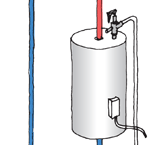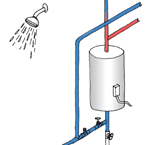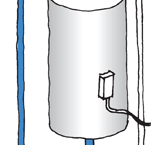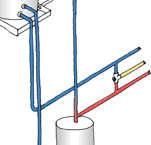Water
Water use, sustainability, and efficiency by choosing quality systems and materials, and providing environmentally friendly solutions.
Controlling pressure in storage cylinders
Most new hot water cylinders are mains pressure, but existing buildings may use low pressure systems.
On this page:
- mains pressure, unvented system
- low pressure, pressure-reducing valve system
- low pressure, open-vented, header tank system
- advantages and disadvantages of different types of storage water heater
Storage water heater systems may operate as:
- a mains pressure, unvented system, where the operating pressure is the same as the incoming supply (120–1,400 kPa, but typically 350–700 kPa)
- a low pressure system that uses a pressure-reducing valve to reduce the mains pressure water (3–12 m head/30–120 kPa)
- a low pressure, open-vented system, where pressure is provided by a cold water storage, header tank (3–12 m head/30–120 kPa). Still found in older homes but not normally installed in new homes today
Mains pressure storage water heaters are the main type of new installation in New Zealand.
Mains pressure, unvented system
Mains pressure, unvented, storage water heater systems supply mains pressure hot water to all outlets so both the hot and the cold water is delivered to outlets at the same pressure. An internal or external expansion vessel allows the heated water to expand, and systems must incorporate a pressure relief valve in case the expansion vessel fails.
All mains pressure cylinders (>120 kPa) require the pressure relief valve to be both pressure and temperature operated (temperature pressure relief or TPR) in order to provide a dual failure mode.
Where a mains pressure unvented system is used, valves must be specified for the particular system to achieve the required pressure rating.
One problem with a single valve for relieving pressure is that hot water is wasted as the water expands during the frequent heat-up cycles. To prevent this, an expansion control valve, set at slightly less pressure, is installed on the inlet side of the cylinder and will relieve cold water during the heat-up cycle. It is normal for an expansion control valve to drip approximately 5 litres of water per day. Both these valves must have a correctly-sized copper drain line that discharges to a safe and visible location.
Low pressure, pressure-reducing valve system
Note: This system may be open-vented or unvented.
The low pressure, open-vented, pressure-reducing valve system works in the same way as the header tank system but uses a pressure-reducing valve to reduce the high pressure water from the mains supply down to a pressure, or head, that is able to be maintained within the height of the vent pipe, which usually discharges above the roof.
This system, commonly known as an unequal pressure system, supplies low pressure hot water and high pressure cold water to fixtures. Its major disadvantage is that it is difficult to achieve balanced flow to a shower.
The unvented, low pressure system must also include a pressure relief valve.
These are old systems that wouldn’t be installed today – modern systems have much better performance.
Valves must be installed so they are:
- accessible for repairs and maintenance
- protected from damage
- protected from frost.
By law, only licensed plumbers can carry out work on water supply pipes and systems.
Low pressure, open-vented, header tank system
Traditionally, low pressure, open-vented systems provided the hot water supply for New Zealand houses. In order to provide adequate hot water supply pressure, cold water is stored in a header tank located at a higher level than the storage water cylinder, from which water is gravity-fed into the bottom of the storage water cylinder.
As the water is heated, it rises to the top of the cylinder where it can be drawn off through taps or shower outlets and will be replaced from the header tank. The gravity feed provides the water pressure that pushes the water to the outlets, as long as they are at a lower level than the stored water.
As heating causes the water within the cylinder to expand, an open-vent pipe provides an outlet for excess pressure. The pipe usually feeds back into the header tank supply.
Advantages and disadvantages of different types of storage water heater | |||
Low pressure, open vented | Low pressure, pressure-reducing valve (open vented or unvented) | Mains pressure, unvented | |
Advantages | |||
Inexpensive to install and maintain | * | * | |
Few valves required | * | * | |
Equal pressure system | * | * | |
Unequal pressure system | * | ||
High pressure hot water | * | ||
Quick hot water delivery | * | ||
Smaller diameter pipework may be used | * | ||
Greater flexibility of pipe layout | * | ||
Quiet operation | * | ||
Wet back connection OK | * | *(if open-vented) | |
Disadvantages | |||
Larger diameter pipework required | * | *(for hot water supply) | |
Grading to avoid air locking essential | * | ||
Low pressure supply | * | *(for hot water) | |
Prone to pressure fluctuations | * | * | |
Noisy and subject to water hammer | * | ||
More water wastage | * | ||
More valves required | * | ||
Increased wear and tear on pipes and fittings | * | ||
Difficult to install wetback | * | ||
Update: 26 November 2020





